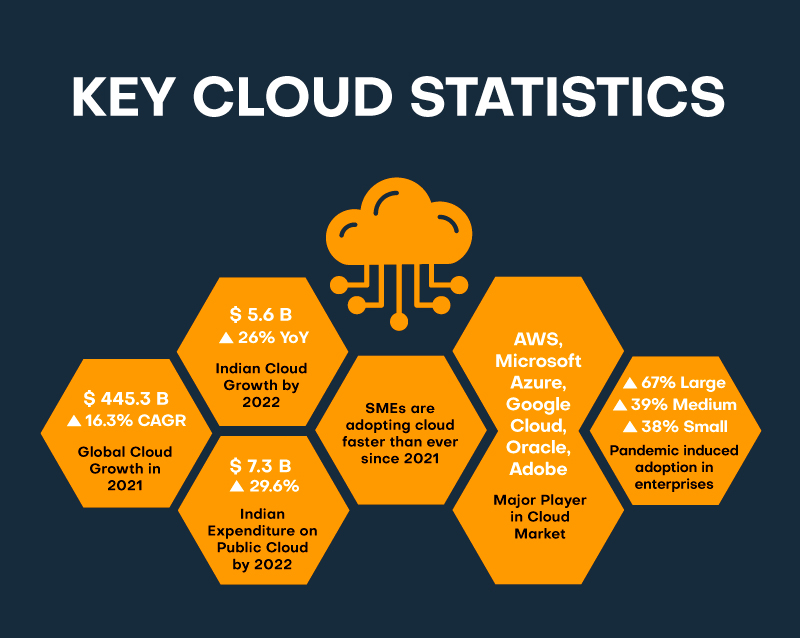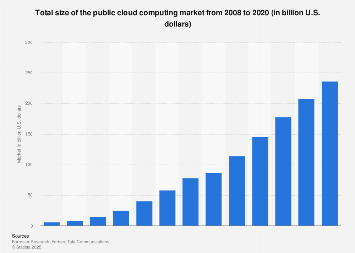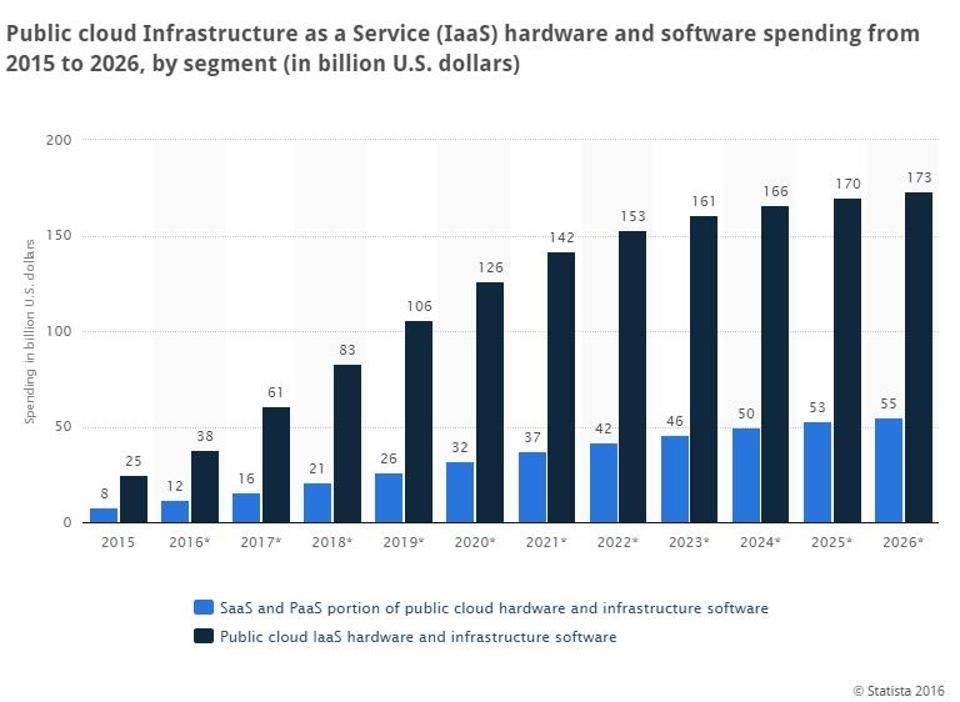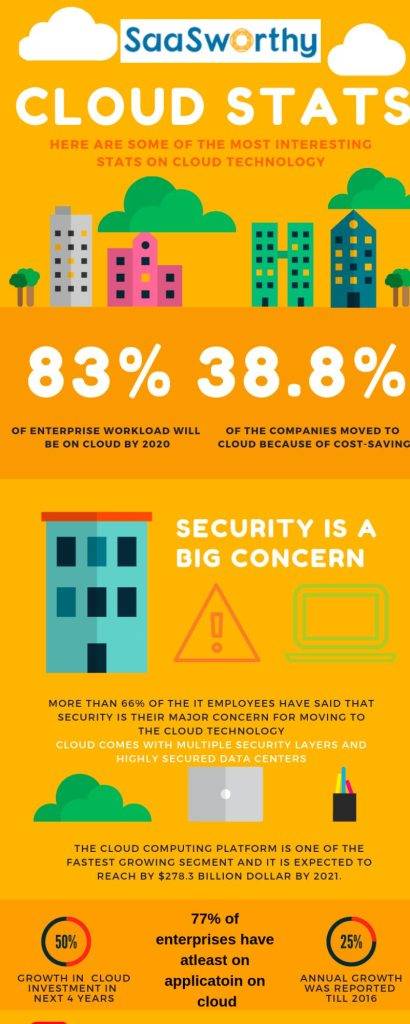Cloud computing delivers services like servers, databases, storage, analytics, software, networking, and intelligence over the internet or the cloud, offering faster innovation, economies of scale, and flexible resources. With cloud services, you pay for what you use, thus lowering your operating costs. With the cloud, you can run your infrastructure more efficiently and scale per your business’s changing requirements.
Table of Contents
Top Cloud Statistics to Watch Out for

The cloud has become a buzzword in the IT field. Back in the day, people knew very little about this emerging technology hence there were a lot of questions, like how the cloud work, whether it is any different from the regular internet, and how you could join the cloud. Ever since those early noob questions, cloud computing has grown exponentially. Estimated at around $24.65 billion in 2010, it has now crossed the $150 billion mark.
- 81% of all companies have a multi-cloud strategy already implemented or in the works.
- 67% of enterprise infrastructure is based on the cloud.
- Around 82% of the workload resides on the cloud.
- Around 40 zettabytes of data flow through cloud servers and networks.
- The average person uses 36 cloud-based services daily.
- Amazon Web Services has captured the largest cloud computing market share at 32%.
- Platform as a service or PaaS swelled in adoption to 56% by 2020.

- The cloud was always meant to succeed. Back in the day, we stored our data on a local device and copied it on pen drives. The thought of having everything available on the go was genuinely revolutionary. Today, the majority of people and businesses use cloud computing technology daily. Here are some statistics about cloud computing.
- Regarding cloud computing market share, Amazon Web Services is a leader with 32%.
- This year’s largest cloud computing market share is for a category called “other”. AWS comes in second with 32%.
- Other nations’ adoption of cloud technologies will fall behind America by several years by 2022. Cloud computing began in the US and has been leading the way since 2015, per cloud computing statistics by country. By the time 2022 is done, cloud adoption in other countries will be much lower.

- Around half of all people surveyed claimed that cloud usage would be higher than initially planned during the COVID-19 pandemic. The pandemic had an impact, especially on cloud computing growth statistics. A more comprehensive survey by Flexera was conducted to check the effect of the pandemic on cloud growth. More than half of 187 respondents said cloud usage might be more than expected because of the extra capacity required to meet demands.
- Platform as a service or PaaS increased in adoption to 56%. Back in 2017, it was only 32%. In 2021, it was expected to rise to 56%, the fastest-growing segment in cloud platforms.
- Dropbox and iCloud are the most popular free cloud storage services, with around 300 million users on each platform. File storage is one of the most popular uses of cloud services. While there are many paid options, there are some great free alternatives. iCloud on Mac and Dropbox have several users on their platforms.
- The number of cloud-based apps has nearly tripled between 2013 and 2016, from 545 to around 1427 services. According to research carried out, there is a growing trend in the adoption of cloud computing by big firms. Nowadays, companies are moving towards a no-office operation, so connecting employees and sharing information through a secured network is required.
- According to cloud adoption statistics, 83% of companies’ workload was stored on the cloud in 2020. A large number of companies have migrated from private to public cloud. Even though a public model might give you less control, you still get security and ease of access.
- Manufacturing, professional services, and banking are the sectors that spend the most on cloud computing. If we consider cloud adoption by industry, companies with a lot of data are the most active investors. Innovations in cloud technology are used quite a lot in banking. Bankers need to retrieve sensitive information from different secure locations.

- Cloud-based apps can help companies with collaborative tasks, content and file sharing, and data security. On average, an employee uses 36 cloud-based services in their daily routine. There are plenty of applications of cloud computing that have yielded many benefits. There are around 210 services in the “collaboration” category alone. The average enterprise uses about 1400 cloud-based apps with such a repository of solutions.
- By 2021, the public cloud market will reach $338 billion. That figure is $187 billion more than it was in 2017. Software as a Service (SaaS) will be the most significant contributor with $190 billion. From 2021 to 2025, this sector will show a Compound Annual Growth Rate (CAGR) of 19%; consequently, the market volume will reach $679 billion by 2025.
- For the public cloud, the future looks promising. Revenue from the public cloud sector may jump to $331 billion by 2022, up from $175.8 billion in 2018. That is a 17.5% growth from 2018 to 2019.
- The more we adopt cloud services, the more we need additional IT infrastructure. This trend will carry on its effect on the IT market. Expect public cloud vendors to extend their influence and get rich in return. Spending on IT infrastructure is slated to hit $55.7 billion by this year. According to cloud computing statistics from IDC, a 10.9% growth rate is expected for demand for servers, enterprise storage solutions, and Ethernet switches.
- Companies are finding it tough to contain their cloud spending. Costs are spiraling out of control because enterprise cloud adoption is rising. It is getting tougher to set accurate budgets. Projections have been made, but they’re oversight by 24% on average. Companies need to optimize their costs, so resources are appropriately allocated. Around 70% of firms use the cloud plan to increase their budgets.
- Hybrid and multi-cloud strategies use technologies from both public and private cloud models. According to 74% of enterprises, they are getting the best of both worlds and thus define their strategy as a hybrid or multi-cloud. Companies may employ a mix of on-premise and third-party, public service (hybrid), or various public providers (multi); most firms realize that diversification is key to survival. Security and efficiency are the most important, with cloud computing statistics showing businesses aren’t scared of applying a more complex infrastructure.

- According to A State of the Cloud report, companies are moving towards implementing a multi-cloud strategy. 84% of surveyed companies claim their IT infrastructure is multi-cloud. The hybrid cloud strategy is still below 60%. This shows that firms are moving away from on-premise infrastructure and shifting their operations to third-party servers. Public cloud is the most preferred cloud service type, with 91% of respondents using such tech.
- In 2020, 46% of data in European nations were in cloud storage. Nearly half of all surveyed companies in Europe will use cloud storage in 2020. Enterprise agility was facilitated by the data environment. Approximately 43% of this data is confidential, and its location must remain secure to reduce risks in the cloud. Only half of this data has encryption protection, while just 44% of this data is under tokenization.
- The positive impact of cloud technology is immediate. Around 80% of companies report operation improvements after just a few months of adopting the tech. Startups and SMBs were considered for this research. Tech adoption among small businesses grows yearly, with CEOs reporting the first positive results within a few months.
- Affordability is a significant reason for the explosive growth of the public cloud. Small and medium enterprises find employing third-party cloud platforms 40% more cost-effective than maintaining an in-house system. Not everyone can afford in-house infrastructure, supporting staff, and the time involved for setup and maintenance. Over that, you need to ensure your operations are safe and secure. Public cloud computing companies might not grant you much control, but the setup ensures that your data is kept isolated and secured from breaches.
- Reliability is not an issue with cloud technology. 94% of companies report improvements in online security after migrating to the cloud. According to 91%, cloud tech is beneficial, especially in dealing with government compliance requirements. Cloud infrastructure firms apply advanced encryption methods while transmitting data so no unauthorized user can access your private information.
- According to 34% of surveyed companies, cloud computing was higher than initially planned, thanks to Covid-19. Cloud computing statistics for 2023 tell us that over 30% of SMBs used more cloud computing than they planned initially, courtesy of the pandemic. According to 52%, it was higher than expected. These numbers occurred because people were forced to work from home.
- There are many reasons why a company would choose the cloud. 71% are seeking speed improvements, 63% are looking for more flexibility, and 57% picked improved customer support as the reason. Organizations that employ more than 1000 people are looking for flexibility and reduced operational costs. At the same time, smaller firms want to ensure business continuity.
Thus, the above statistics can give you a clear picture of cloud computing. With the world moving towards digital day by day, cloud.






